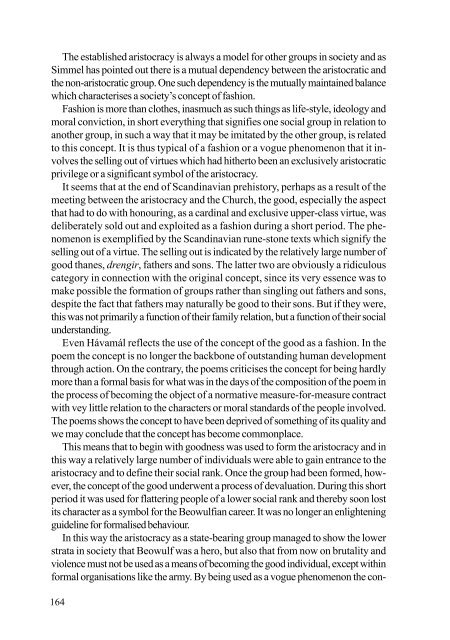Beowulf - Institutionen för arkeologi och antik historia
Beowulf - Institutionen för arkeologi och antik historia
Beowulf - Institutionen för arkeologi och antik historia
You also want an ePaper? Increase the reach of your titles
YUMPU automatically turns print PDFs into web optimized ePapers that Google loves.
The established aristocracy is always a model for other groups in society and as<br />
Simmel has pointed out there is a mutual dependency between the aristocratic and<br />
the non-aristocratic group. One such dependency is the mutually maintained balance<br />
which characterises a society’s concept of fashion.<br />
Fashion is more than clothes, inasmuch as such things as life-style, ideology and<br />
moral conviction, in short everything that signifies one social group in relation to<br />
another group, in such a way that it may be imitated by the other group, is related<br />
to this concept. It is thus typical of a fashion or a vogue phenomenon that it involves<br />
the selling out of virtues which had hitherto been an exclusively aristocratic<br />
privilege or a significant symbol of the aristocracy.<br />
It seems that at the end of Scandinavian prehistory, perhaps as a result of the<br />
meeting between the aristocracy and the Church, the good, especially the aspect<br />
that had to do with honouring, as a cardinal and exclusive upper-class virtue, was<br />
deliberately sold out and exploited as a fashion during a short period. The phenomenon<br />
is exemplified by the Scandinavian rune-stone texts which signify the<br />
selling out of a virtue. The selling out is indicated by the relatively large number of<br />
good thanes, drengir, fathers and sons. The latter two are obviously a ridiculous<br />
category in connection with the original concept, since its very essence was to<br />
make possible the formation of groups rather than singling out fathers and sons,<br />
despite the fact that fathers may naturally be good to their sons. But if they were,<br />
this was not primarily a function of their family relation, but a function of their social<br />
understanding.<br />
Even Hávamál reflects the use of the concept of the good as a fashion. In the<br />
poem the concept is no longer the backbone of outstanding human development<br />
through action. On the contrary, the poems criticises the concept for being hardly<br />
more than a formal basis for what was in the days of the composition of the poem in<br />
the process of becoming the object of a normative measure-for-measure contract<br />
with vey little relation to the characters or moral standards of the people involved.<br />
The poems shows the concept to have been deprived of something of its quality and<br />
we may conclude that the concept has become commonplace.<br />
This means that to begin with goodness was used to form the aristocracy and in<br />
this way a relatively large number of individuals were able to gain entrance to the<br />
aristocracy and to define their social rank. Once the group had been formed, however,<br />
the concept of the good underwent a process of devaluation. During this short<br />
period it was used for flattering people of a lower social rank and thereby soon lost<br />
its character as a symbol for the <strong>Beowulf</strong>ian career. It was no longer an enlightening<br />
guideline for formalised behaviour.<br />
In this way the aristocracy as a state-bearing group managed to show the lower<br />
strata in society that <strong>Beowulf</strong> was a hero, but also that from now on brutality and<br />
violence must not be used as a means of becoming the good individual, except within<br />
formal organisations like the army. By being used as a vogue phenomenon the con-<br />
164








